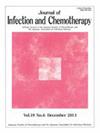万古霉素达到目标浓度-时间曲线下面积的相关流程图的外部验证:一项多中心回顾性研究
IF 1.9
4区 医学
Q3 INFECTIOUS DISEASES
引用次数: 0
摘要
在万古霉素(VCM)的治疗药物监测(TDM)中,浓度-时间曲线下面积(AUC)是平衡药效与毒性的重要指标。在之前的研究中,我们开发了一个决策树(DT)模型来实现TDM期间随访期间(aucfollow)的目标AUC。本研究旨在验证DT模型实现auc随访的目标。对2023年1月至2023年12月期间接受VCM治疗至少72小时并在四次剂量内出现初始TDM的患者进行了分析。通过贝叶斯估计计算初始TDM在2点(峰/谷)浓度上的AUC。auc随访目标定为400 ~ 600 μg h/mL。188例患者(中位年龄[四分位数间距]66[56,79]岁;50%为女性),70%(132/188)达到了auc随访目标。当AUC预测值为400 ~ 600 μg h/mL时,84%(102/121)达到AUC随访目标。在12小时给药间隔亚组中,86%(88/102)达到了auc随访目标。相反,当预测AUC为400或600 μg h/mL时,达到AUC随访目标的比例降至44%(30/67)。在肌酐清除率为130 mL/min/1.73 m2的患者中,只有30%(3/10)达到了目标。受试者工作特征曲线下面积为0.74,R2为0.15。我们的研究结果证实了DT模型的外部有效性,并支持其用于优化VCM剂量。总的来说,DT模型为TDM随访期间实现目标AUC值提供了可靠的框架,有助于安全有效的治疗。本文章由计算机程序翻译,如有差异,请以英文原文为准。
External validation of a flowchart related to achieving the target area under the concentration-time curve for vancomycin: A retrospective multicenter study
During therapeutic drug monitoring (TDM) for vancomycin (VCM), the area under the concentration-time curve (AUC) is important for balancing efficacy versus toxicity. In a previous study, we developed a decision tree (DT) model to achieve the target AUC during TDM over the follow-up period (AUCfollow-up). This study aimed to validate the DT model for achieving the target AUCfollow-up. Patients who received VCM for at least 72 h and had an initial TDM within four doses between January 2023 and December 2023 were analyzed. The AUC of the initial TDM was calculated over 2-point (peak/trough) concentrations via Bayesian estimation. The target AUCfollow-up was defined as 400–600 μg h/mL.
Among 188 patients (median age [interquartile range], 66 [56, 79] years; 50 % female), the target AUCfollow-up was achieved in 70 % (132/188). When the predicted AUC was 400–600 μg h/mL, 84 % (102/121) achieved the target AUCfollow-up. In a 12 h dosing interval subgroup, 86 % (88/102) achieved the target AUCfollow-up. Conversely, when the predicted AUC was <400 or >600 μg h/mL, the proportion who achieved the target AUCfollow-up dropped to 44 % (30/67). Only 30 % (3/10) of those with creatinine clearance rates of >130 mL/min/1.73 m2 achieved the target. The area under the receiver operating characteristics curve was 0.74, and the R2 value was 0.15.
Our findings confirmed the external validity of the DT model and supported its use for optimizing VCM dosing. Overall, the DT model offers a reliable framework for achieving target AUC values during follow-up for TDM, aiding safe and effective treatment.
求助全文
通过发布文献求助,成功后即可免费获取论文全文。
去求助
来源期刊

Journal of Infection and Chemotherapy
INFECTIOUS DISEASES-PHARMACOLOGY & PHARMACY
CiteScore
4.10
自引率
4.50%
发文量
303
审稿时长
47 days
期刊介绍:
The Journal of Infection and Chemotherapy (JIC) — official journal of the Japanese Society of Chemotherapy and The Japanese Association for Infectious Diseases — welcomes original papers, laboratory or clinical, as well as case reports, notes, committee reports, surveillance and guidelines from all parts of the world on all aspects of chemotherapy, covering the pathogenesis, diagnosis, treatment, and control of infection, including treatment with anticancer drugs. Experimental studies on animal models and pharmacokinetics, and reports on epidemiology and clinical trials are particularly welcome.
 求助内容:
求助内容: 应助结果提醒方式:
应助结果提醒方式:


